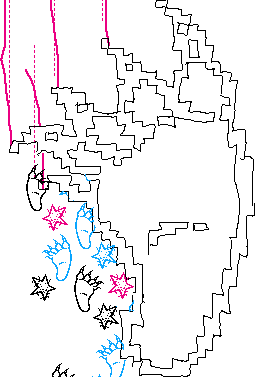| (1) GENERATION FLASH (2) FAQ (3) UTOPIA IN SOFWARE (4) THE UNBEARABLE LIGHTNESS OF FLASH (5) ART, MEDIA AND SOFTWARE ART (6) POSTSCRIPT LEV MANOVICH, 2002 (7) WEBSITES, THE ART OF OUR TIMES MILTOS MANETAS , 2002 (8) FLASH IS POPTECH PETER LUNENFELD, 2001
UTOPIA in Shockwave by Lev Manovich
[UTOPIA is a Shockwave project by Futurefarmers for Tirana Biennale Internet section.] [Futurefarmers
: Amy Franceschini and Sascha Merg]
UTOPIA is playful and deceitful - because it pretends to be more innocent, more simple, and more light than it actually is. At first glance it can be taken for something made for children - or for adults whose references are not Karl Marx, Sigmund Freud, Rem Koolhaas, and Philip Stark, but text messaging, gnuttela, retro Atari graphics, and nettime. This is the new generation that emerged in the 1990s. In contrast to visual and media artists of the 1960s-1980s, whose main target was media - ads, cinema, television - the new generation does not waste its energy on media critique. Instead of bashing commercial media environment, it creates its own: Web sites, mixes, software tools, furniture, cloves, digital video, Flash / Shockwave animations and interactives. The new sensibility, which Utopia exemplifies so well, is soft, elegant, restrained, and smart. This is the new software intelligentsia. Look at the thin low-contrast lines of UTOPIA, praystation.com, and so many Flash projects included in Tirana Biennale. If images of the previous generations of media artists, from Nam June Paik to Barbara Kruger, were screaming, trying to compete with the intensity of the commercial media, the new data artists such as Franceschini/Merg whisper in our ears. In contrast to media's arrogance, they offer us intelligence. In contrast to media stream of endless repeated icons and sound bytes, they offer us small and economical systems: stylized nature, ecology, or the game / music generator / Lego-like parade in UTOPIA. Futurefarmers are among the few Flash/Shockwave masters who use their skills for social rather than simply a formal end. Their project theyrule.net is a great example of how smart programming and smart graphics can be used politically. Instead of presenting a packaged political message, it gives us data and the tools to analyze it. It knows that we are intelligent enough to draw the right conclusion. This is the new rhetoric of interactivity: we get convinced not by listening / watching a prepared message but by actively working with the data: reorganizing it, uncovering the connections, becoming aware of correlations. UTOPIA does not have explicit political content; instead it presents its message through a visual allegory. Like SimCity and similar sims, the program presents us with a whole miniature world which runs according to its own system of rules. (All the animation in UTOPIA is result of code execution – nothing is hand animated. ) The cosmogony of this world reflects our new understanding of our own planet - post Cold War, Internet, ecology, Gaia, and globalization. Notice the thin barely visible lines that connect the actors and the blocks. (This is the same device used in theyrule.net.) In the universe of UTOPIA, everything is interconnected, and each action of an individual actor affects the system as a whole. Intellectually, we know that this is how our Earth functions ecologically and economically - but UTOPIA represents this on a scale we can grasp perceptually. The lines also serve another purpose. Despite CNN, Greenpeace, the glass roof of Berlin’s Reistag and other institutions and devices working to make the functioning of modern societies transparent to their citizens, most of it is not visible. This is is not only because we don't know the motives behind this or that Government policy or because advertising and PR constantly work to make things appear differently from what they really are – the societies’ functioning is not visible in a literal sense. For instance, we don't know where are the cells which make our cell phones work; we don’t know the layout of private financial network that circle the Earth; we don’t know what companies are located in a building we pass everyday on a way to work; and so on. But in UTOPIA, we do know – because the links are made visible. UTOPIA is Utopia because it is a society where cause and effect connection are rendered visible and comprehensible. The program rewrites Marxism as vector graphics; it substitutes the figure of “connections” for the old figure of “unweilling.” UTOPIA is serious business behind its playful façade – but it is not all business. Drawing on our current fascination with computer games and interactive image-sound software, UTOPIA is a visual and intellectual delight, UTOPIA draws on the current fascination with computer games and interactive image-sound software. It is Tetris that meets Marx that meets data mining that meets the club dance floor. It is a game for the new generation that know that the world is a network, that the media is not worth taking very seriously, and that programming can be used as a political tool.
|
![]()
 |
 |
 |